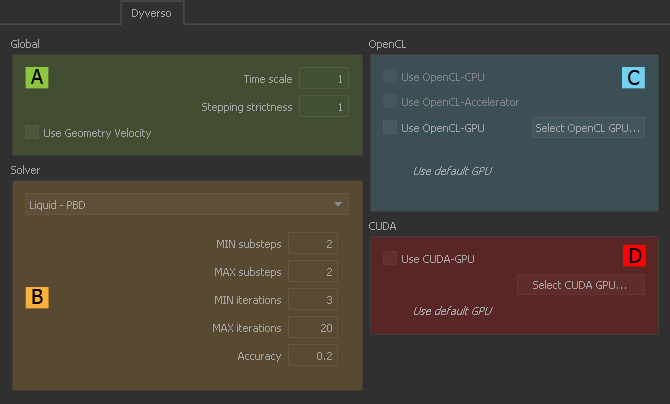Simulation: Dyverso
Jump to
Global (A)
Time scale
Values smaller than 1.0 will decelerate the fluid; settings greater than 1.0 have an acceleration effect. “Time scale” works as a factor: 2.0 means that the fluid will be two times faster.
Stepping Strictness
RealFlow calculates how fast the fluid will move within a substep:
- With a value of 1.0, the fluid will not move more than the distance of 1 particle diameter in the current time step.
- With values smaller than 1.0, the fluid can cover a longer distance within a single step – the solver is less strict.
Use Geometry Velocity
When enabled RealFlow will adjust the simulation's substeps to get a correct fluid-object interaction behaviour:
Imagine an object falling into a container with calm water.
Here, RealFlow uses very large substeps to speed up the simulation.
Due to these large steps the interaction between the object and the fluid is delayed.
With “Use Geometry Velocity” the interaction will happen in time again.
Solver (B)
Here you change the default simulation settings for all Dyverso fluid types. The parameters are exactly the same for all fluid types except "Dumb".
In short, Substeps are “frame subdivisions”, and Iterations is the number of times the solver tries to find a solution to a collision or constraint before giving up.
SUBSTEPS
Sounds more complicated than it is. The simulation is running at your FPS, multiplied by this value.
FPS = 24
Substeps = 4
Simulation = 24 x 4 == 96 FPS
So to the solver, your animation is effectively running in slow-motion. Any problem, like an intersection, is much easier to solve in slow-motion, because there will be collisions to deal with in those substeps. The attribute tries to match the simulation to your animation and if there is less of a difference between the two, the easier it is to solve.
It's good to know that, if your FPS is 48 or 60. You’ll need much less substeps!
MIN substeps
Specify the minimum number of simulation steps for Dyverso fluids:
- Higher values increase simulation time and can lead to instabilities. We recommend moderate increases of just a few substeps.
- For a fixed number of substeps use equal values for “MIN substeps” and “MAX substeps”.
- The default value normally provides the best ratio between speed and accuracy.
MAX substeps
Specify the maximum number of simulation steps for Dyverso fluids:
- Higher values increase simulation time and can lead to instabilities. Try using values around the default setting.
- For a fixed number of substeps use equal values for “MIN substeps” and “MAX substeps”.
- The default value normally provides the best ratio between speed and accuracy.
ITERATIONS
This is a bit more complex. The iterations are the number of calculation cycles the solver tries before staying with the calculated solution. As the solver calculates collisions, forces, constrains, etc. and how they affect their neighbour particles, it can get deeper and deeper into the calculation, however it will take more and more time. At some point it may not be noticeable for the visual result but it can take a lot of calculation time.
(MIN) iterations ("MIN" only for "Liquid - PBD", not for "Dumb")
Specify the minimum number of simulation cycles:
- Higher values increase simulation time, but also avoid instabilities.
- For a fixed number of iterations use equal values for “MIN iterations” and “MAX iterations”.
MAX iterations (only for: "Liquid - PBD")
Specify the maximum number of simulation cycles:
- Higher values increase simulation time, but also avoid instabilities.
- For a fixed number of iterations use equal values for “MIN iterations” and “MAX iterations”.
Generally the choice of Substeps and Iterations is a performance/quality tradeoff. More substeps and iterations means more quality, at the cost of performance. In the case of substeps, very low values can make particles ignore some objects if they are moving too fast (for example, if in one frame the object is far in front of the particle and in the next frame it is far behind).
Accuracy (only for "Liquid - PBD")
This parameter ranges between 0.0 and 1.0. With
- 0.0 RealFlow quickly finds a solution, but it will not be very accurate
- 1.0 RealFlow finds a solution that is very close to the exact behaviour, but simulation time will increase.
OpenCL (C)
Due to the almost infinite number of hardware combinations we cannot guarantee that RealFlow's OpenCL features are available for any computer or graphic device. Please read the → "GPU Simulations" chapter if you encounter performance issues.
Use OpenCL-CPU
This option is only available if your computer supports OpenGL-CPU calculations.
Use OpenCL-GPU
You can activate this option if your graphics card has OpenCL capability, otherwise it is greyed out.
Use OpenCL-Accelerator
This function is only available with dedicated OpenCL-acceleration hardware. These devices have to be purchased separately.
Select GPU...
Got more than one GPU in your computer? Choose here which board you want to use with your Dyverso simulations.
CUDA (D)
Please read the → "GPU Simulations" chapter if you encounter performance issues.
Use OpenCL-CUDA
You can activate this option if your graphics card has CUDA capability, otherwise it is greyed out.
Select CUDA GPU...
Got more than one CUDA GPU in your computer? Choose here which board you want to use with your Dyverso simulations.
